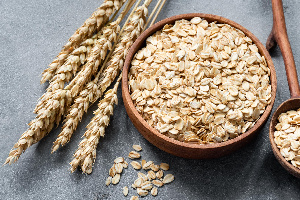BBC Pidgin of Thursday, 13 July 2023
Source: BBC
Di 11 healthiest cereals
Wetin be cereal? Cereal na grass wey farmers dey grow for dia 'fruit' wey dey edible, better known as grain.
Usually dem dey grow cereals in large quantities and e dey provide more food energy dan any other crop, both directly for human consumption and indirectly for livestock feed.
For dia natural state, unprocessed form, cereals dey rich in vitamins, minerals, carbohydrates, fats, oils and proteins.
Many pipo dey confuse buckwheat and quinoa as cereals but dem actually be plant seeds. But as dia culinary uses dey similar, we include dem as part of our selection.
1. Wheat (Triticum)
Wheat, one of di most widely consumed cereals, and e cousins (durum wheat, spelt, etc.) na important source of carbohydrates.
Wholemeal wheat include di three parts of di grain: di bran, di germ and di endosperm. Im natural nutrients and fibre dey preserved.
Dis na why wholemeal wheat dey rich in nutrients and, if pesin eat am regularly, e fit help protect against chronic diseases such as heart disease and stroke, certain forms of cancer and type 2 diabetes.
In small proportion of di population, gluten (di bulk of wheat protein) fit trigger autoimmune condition wey dey known as coeliac disease, or lead to condition called non-celiac gluten sensitivity.
As an ingredient, wheat dey extremely versatile: e make up most of our daily bread and dey available in di form of pasta, couscous, semolina and bulgur.
2. Barley
Pearl barley na di most common variety. E no be complete cereal and, although e na good source of certain nutrients, e no dey good as hulled barley, from which dem don remove only di outer husk.
But barley na source of soluble fibre wey dey known as beta-glucans, wey appear to influence energy metabolism as e dey indirectly suppress appetite and improve insulin sensitivity.
Like wheat, barley na cereal wey contain gluten and therefore e no dey suitable for pipo wey get coeliac disease or non-celiac gluten sensitivity.
3. Maize
Maize aka corn na one of di most widely consumed cereals in di world.
As well as being a source of vitamins, minerals and fibre, maize dey provide plant compounds, in particular di carotenoids lutein and zeaxanthin.
In fact, maize dey provide more of dis protective plant compounds dan most other cereals.
Diet wey dey rich in dis compounds fit reduce di risk of heart disease, cancer and obesity, and protect against vision loss.
4. Millet
Although e look like seed, millet na gluten-free cereal wey contain lots of fibre, protein and protective antioxidants.
Wit low glycaemic index and rich in non-digestible carbohydrates, millet fit help stabilise blood sugar levels.
5. Oats
Oats dey rich in prebiotic fibre, particularly beta-glucan, wey be soluble fibre.
Prebiotic fibre act as a source of fuel for di microbes wey dey our intestine and, in doing so, e dey stimulate dia growth and activity, as e dey enable dem to crowd out less pathogenic microbes wey di body need.
Prebiotic fibre dey important for promoting healthy intestinal environment, e dey maintain correct intestinal function and dey minimise inflammation.
6. Rice
Rice na one of di world's most important dietary carbohydrates, over half of di population for di world depend on am. Generally boiled or steamed, you fit also mill am to produce gluten-free flour.
Brown rice retain di bran layer and therefore contain protective compounds wey dey known as flavonoids, including apigenin and quercetin. Dis compounds play important role in protecting against disease.
7. Rye
Rye dey rich in lignans, plant compounds wey dey associated wit plenty health benefits, including reduced risk of heart disease, menopausal symptoms, osteoporosis and breast cancer.
Studies confirm say bread wey dem make from 100% rye get fewer negative effects on blood sugar levels dan di one dem make wit wheat and therefore e dey likely to keep you fuller for longer.
8. Sorghum
Although many pipo no sabi am, sorghum na di fifth most widely produced cereal in di world.
E contain no gluten and you fit cook am like rice, ground am into flour or make am like popcorn. As whole form, e dey nutrient-dense, low in fat and high in fibre.
Sorghum na better source of magnesium dan wheat and e dey rich in plant compounds, particularly flavonoids, phenolic acids and tannins. Dis compounds dey known for dia beneficial effects on health, particularly as anti-inflammatories, antioxidants and anti-diabetics.
9. Triticale
A cross between wheat and rye, dis gluten-containing cereal contain more protein dan e cousins.
E also dey rich in minerals and vitamins. E gluten content dey lower than that of wheat, e dey preferable to mix am wit wheat flour to make bread.
10. Buckwheat
Buckwheat get an enviable antioxidant profile, e dey better dan dat of many cereals, including oats and wheat.
E contain plant compounds such as rutin and na one of di richest food sources of d-chiro inositol, which fit help manage blood sugar levels.
Despite im name, buckwheat actually be seed rather dan grain. Buckwheat naturally dey gluten-free.
11. Quinoa
Quinoa dey rich in anti-inflammatory plant compounds, e dey potentially beneficial for di prevention and treatment of disease.
Quinoa contain small amounts of heart-healthy omega-3 fatty acids and dey higher in monounsaturated fats dan common cereals.
Entertainment













